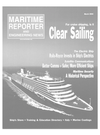
Page 13: of Maritime Reporter Magazine (March 2004)
The Cruise Shipping Edition
Read this page in Pdf, Flash or Html5 edition of March 2004 Maritime Reporter Magazine
Government Update
Black Tom Island became a focal point for these shipments. Small arms ammu- nition, detonating fuses, and TNT were regularly shipped from this facility located across from New York City.
Federal oversight was minimal and security was virtually nonexistent.
Passes were not required to gain access to the facility. July 29-30. 1916, was a weekend. The longshoremen had departed, along with the railroad work- ers and crewmembers. Four security guards were present to patrol the entire terminal and piers, but they were more concerned about avoiding the clouds of mosquitoes. At about 2:45 on Sunday morning, flames were observed coming from one of the hundreds of boxcars loaded with explosives. The security guards immediately fled the facility, stopping only to set off the fire alarm.
The explosions lit up the sky over Jersey
City. Shrapnel and debris struck build- ings miles away. People were thrown from their beds in northern New Jersey,
Manhattan. Staten Island, and Brooklyn.
In homes and buildings in area, includ- ing many Manhattan skyscrapers, win- dows facing the site were blown in and windows opposite the site were blown out. Thousands of terrified people lied to the streets, unaware of the source of the destruction. The shock wave was felt as far away as Philadelphia.
Explosions continued until dawn. In the morning. Black Tom Island, the railroad terminal, the boxcars and locomotives, the piers, and the ships and barges moored there were gone. Miraculously, only four persons were known to have died in the catastrophe, including the master who lived aboard one of the barges. Total damage was estimated to be $40 million. Liberty State Park, across from Ellis Island, now occupies the site of the Black Tom Island explo- sion.
While German saboteurs were imme- diately suspected as being the cause of the destruction, it wasn't until 1939 that the German government finally admit- ted culpability and paid a total of $50 million in damages for both the Black
Tom incident and the January 1917 explosion at a Kingsland, New Jersey munitions plant.
Congress, though, did not wait. On
June 15, 1917 (less than one year after the Black Tom catastrophe), it enacted the Espionage Act, giving authority to the U.S. Coast Guard to regulate the anchorage and movement of ships in
U.S. waters. By this time, the United
States had entered World War I on the
Allied side. The Coast Guard
Commandant, Commodore Ellsworth
March 2004
Circle 203 on Reader Service Card
Bertholf, promptly designated the senior
Coast Guard officers in New York,
Philadelphia, Norfolk, and Sault Ste.
Marie as Captains of the Port (COTP) to enforce the Espionage Act.
Captain Godfrey L. Carden, com- mander of the Coast Guard's New York
Division, was COTP New York through- out World War I. The majority of the nation's munitions shipments overseas left through New York. For a period of 11/2 years, more than 1,600 vessels, car- rying more than 345 million tons of explosives, sailed from this port. In 1918, Carden's unit was the largest sin- gle command in the Coast Guard. It was made up of 1,400 officers and men, four
Corps of Engineer's tugs and five harbor cutters. His pioneering work defined the
Coast Guard's port security mission for the next 60 years.
Port security activities and enforce- ment of the Espionage Act largely termi- nated with the end of the war in
Our competition doesn't like the water, either.
YOUR ULTIMATE WAY OUT
ACR Electronics, Inc., 5757 Ravenswood Road, Fort Lauderdale, FL 33312, U.S.A.
For information call (954) 981-3333 • e-mail: [email protected] • www.acrelectronics.com/mr -A Chelton Group Company
In a government test designed to measure perform- ance in real world conditions, ACR's ClobalFix1" and
RapidFix1" were the only EPIRBs tested to acquire and provide GPS data every single time - without fail - within seconds while floating at sea.
When you need help from Search and Rescue, you need it in a hurry. An
ACR GPS EPIRB is the only sure way to get it, utilizing the highly successful
COSPAS-SARSAT satellite system (which has saved more than 15,000 lives in the past 20 years).
ACR's superior performance is evident from its better-than- required electronic design to its proprietary FastACQ1" CPS acquisition software. ACR is also committed to convenience and service through its unparalleled, worldwide Authorized
Battery Replacement Center network. \ For complete government test results, log onto ? www.acrelectronics.com/mr. You'll be convinced that o s any GPS EPIRB that can't provide encoded data while it's in the water, is a GPS EPIRB you can live without.

 12
12

 14
14
